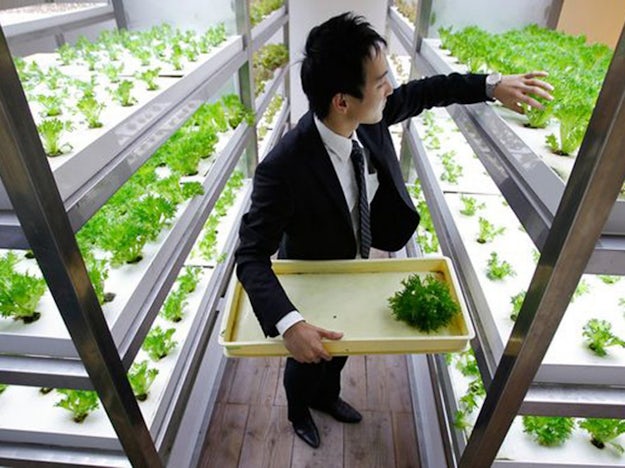UK Urban Agritech caught quite some attention last week when they published a new concept report on the possibilities that vacant office space can offer for the Controlled Environment Agriculture (CEA) sector. The preliminary research has proven quite hopeful in showing potential for new ways of implementing innovative agriculture in the urban environment.
UK Urban AgriTech (UKUAT) is a founding member of FarmTech Society, and exemplifies the innovative spirit and creative outlook, we are proud to represent.
Might we catch office gossip at the watercress rather than the water cooler soon?

Farming Cities
Urban agriculture in general has a lot of potential. This potential, however, is dependent on successfully crossing three major hurdles: productivity, profitability, and public support. If successful, added value held by urban agriculture is plentiful; ranging from reducing food miles and making the farm-to-fork supply chain more transparent, to reducing food waste and even mitigating the urban heat island effect. Urban heat islands (where cities are hotter than the surrounding areas) have effects on the weather patterns far outside the urban areas. Greening cities, including through urban agriculture, can significantly reduce this effect and make cities more liveable.
It makes sense, then, that urban agriculture is often looked at as interesting business opportunities. The CEA sector, with its innovative approach and entrepreneurial spirit, is first in line to see to these opportunities. The urban environment is also perfectly suited for CEA: energy and water nets are only to be hooked onto!
Growing at the office
The true embodiment of the out-of-the-box attitude so  characteristic of our sector, UKUAT explored the opportunities of the pandemic and work moving homewards, by entering in a thought experiment: “what if we filled empty offices with crops?”.
characteristic of our sector, UKUAT explored the opportunities of the pandemic and work moving homewards, by entering in a thought experiment: “what if we filled empty offices with crops?”.
The paper recognises two scenarios: in the first one, whole offices would be repurposed for food production. Betting on the drop in wanted office stock really kicking in could see this as a possibility. The second, and in my opinion the most interesting scenario is creating mixed use spaces. Part growing area, part work environment, this scenario combines the growing potential and productivity, with an aesthetic purpose. In addition to growing, the office finds itself with a talking point, food transparency, and originality. This does ‘tick more boxes’ recognised in the hurdles towards urban agriculture in that it engages with people more.
Using hydroponics, the mix of crops would be mainly focused on leafy greens and herb crops (although rapid developments in the sector could offer more variety down the road). Energy use (heating, ventilation, and lighting) were found to be approximately equal to the heat generated by occupants of a well-occupied office, so your plant neighbour does not need his space heater on.
‘It’s the economy, Stupid!’
With economic viability comes a bit of a catch: conservative to self-proclaimed ‘pessimistic’ views, see a £200/m2/year shortfall for these systems in vacant office space. High labor costs are the main culprit: having to spread one’s urban farm over three or four buildings is not the most efficient approach. This does, however, gives more viability to the first scenario where the more intensive nature makes the labor costs subject to more economies of scale. In addition, hope arises through technological advancement such as more automation and on-site renewable energy, possible subsidies, and possible lower costs of occupancy in the future.
Looking at the bigger picture – and momentarily moving away from solely discussing the publication, these ideas hold more value than a novel approach to food production. With more and more people moving to urban areas, urban agriculture can offer solutions to urban issues such as food deserts; shorter supply chains help combat food waste and help the most vulnerable people in cities to healthy and nutritious food. It can strengthen the link people have with food and nature, being an important step in the challenge of bridging the rural-urban divide. Lastly, urban agriculture can help communities come together, and offer employment opportunities.
UK Urban AgriTech’s idea is novel, yet not out of reach; Tokyo’s Passona Offices have tomato plants in boardrooms and even a rice paddy in the lobby. All the while its walls and green roof do not only impact the office’s temperature, but that of the surrounding area.
Urban agriculture is very much the future, and should not be considered a gimmick, rather it can bring solutions to cities that span much wider than just nutrition.




